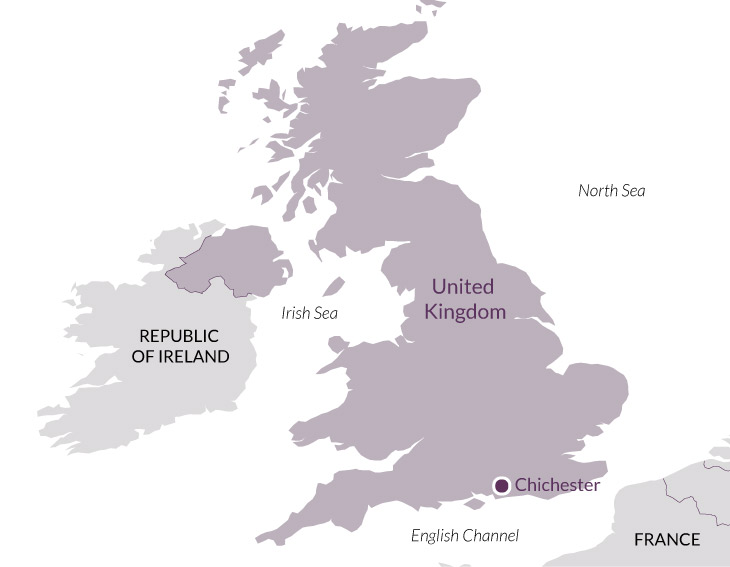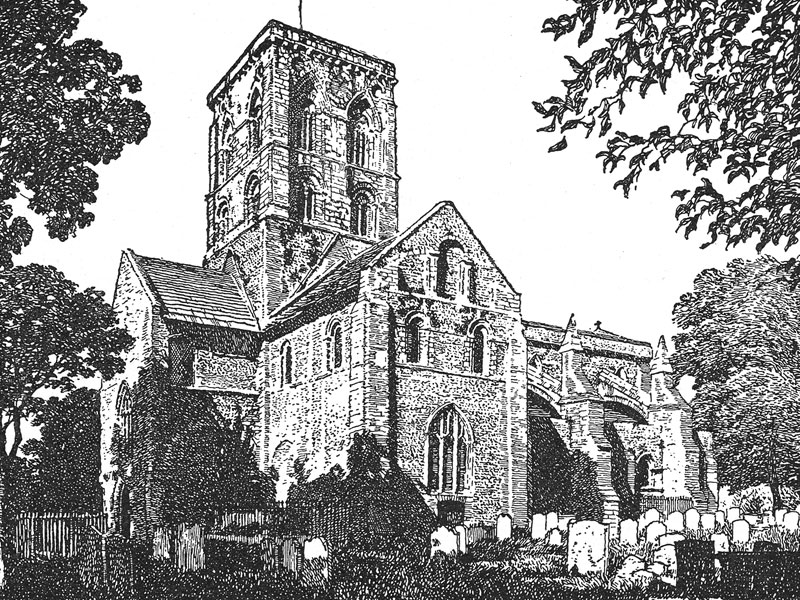Overview
Famed for its seaside churches and the quality and virtuosity of its Romanesque architecture, the area at the western end of the South Downs, essentially West Sussex and East Hampshire, boasts one of the richest collections of mediaeval churches to survive in southern England. It is also, unusually, an area where one might pick out examples from every important phase of church building in mediaeval England – from the early Anglo-Saxon tower at St Peter’s, Titchfield, to Richard Fox’s magnificent early-sixteenth-century remodelling of the presbytery at Winchester cathedral.
That said, the tour develops around three overlapping themes. The first concerns the effects of the Norman Conquest – the creation of great fortifications at Portchester and Arundel, the move of the See of Sussex from Selsey to Chichester, and the establishment of a new type of great church architecture in Chichester and Winchester cathedrals.
The second of these themes is aesthetic and concerned with the type of architecture that developed towards the end of the twelfth century. As with much of south-east England, Hampshire and West Sussex experienced large-scale rebuilding during the period c. 1150–1220, the greatest evidence for which is to be found at Steyning, Bosham, New Shoreham and Boxgrove. Distinctive approaches to the late Romanesque and early Gothic interior are a great feature of Sussex churches, immeasurably enhanced by the subtle juxtaposition of creamy limestone and polished dark marble colonettes.
The last of the tour’s main themes is commemorative. At around the date that the first of Winchester cathedral’s chantry chapels was created, the chancel of the parish church at Arundel was made collegiate, and effectively brought within the castle wall. The result was to turn the east end of Arundel into an aristocratic mausoleum, while Winchester developed the most impressive series of episcopal chantries to survive in Europe. Taken together, the two afford an exceptional insight into English late-mediaeval tomb design.
Day 1
Chichester. Leave Chichester railway station on foot at 2.15pm for the short walk to Chichester cathedral, Ian Nairn’s ‘well-worn, well-loved, comfortable fireside chair of a cathedral’, and a building best approached as a series of quirky set-pieces woven around an Anglo-Norman core, complete with retrochoir, eccentric cloister, and superb late mediaeval furnishings.
Day 2
Shoreham, Sompting, Steyning, Arundel. A gentle drive west beneath the South Downs to Old and New Shoreham, whose juxtaposition of an aisleless cruciform church on high ground (Old Shoreham), and a magnificent early 13th-century quayside aisled parochial chancel (New Shoreham), should open the day. Thence to a great pair of 11th- and 12th-century Sussex churches, Sompting and Steyning, before rounding off the day at mighty Arundel Castle.
Day 3
Winchester, Romsey. A perfect opportunity to slip west into Hampshire, with Winchester cathedral the day’s principal objective; library, monastic precinct, chantry chapels, crypt and all. An afternoon walk through the flood meadows to the great hospital of St Cross, whose 15th-century almshouses and hall survive more or less intact, and on to the former royal nunnery at Romsey Abbey, possessor of the best preserved Romanesque east end in England.
Day 4
Portchester, Netley, Titchfield, Boxgrove. A day of local horizons, starting with the extraordinary late-Roman Saxon shore fort at Portchester, home to an important Augustinian church and royal castle, and progressing via two great monastic ruins, Cistercian Netley and 13th-century Titchfield. Lunch is included in Titchfield, after which we will continue to its stunning little parish church and the magnificent former priory at Boxgrove.
Day 5
Bosham, Fishbourne, Chichester. Begin with the loveliest of the harbour churches at Bosham. A gentle drive along the northern shore of Chichester Harbour to Fishbourne, site of perhaps the greatest Roman villa to have been constructed in England and one of the greatest north of the Alps. Then back into Chichester for a visit to the important late mediaeval foundation of St Mary’s Hospital, famed for its superb late-mediaeval choir stalls. The coach returns to Chichester railway station by 3.30pm.
Price – per person
Two sharing: £1,540. Single occupancy: £1,780.
Included
Travel by private coach; hotel accommodation; breakfasts, one lunch and three dinners with wine, water, coffee; all admissions and donations; tips for restaurant staff and drivers; the services of the lecturer.
Accommodation
Harbour Hotel, Chichester. A smart, boutique hotel in the centre of town. This 4-star hotel is within walking distance of the Cathedral and Pallant Gallery. Single rooms are doubles for sole use.
How strenuous?
This tour involves quite a lot of getting on and off coaches and standing around and should not be attempted by anyone who has difficulty with everyday walking and stair-climbing. Average distance by coach per day: 49 miles.
Are you fit enough to join the tour?
Group size
Between 10 and 22 participants.

